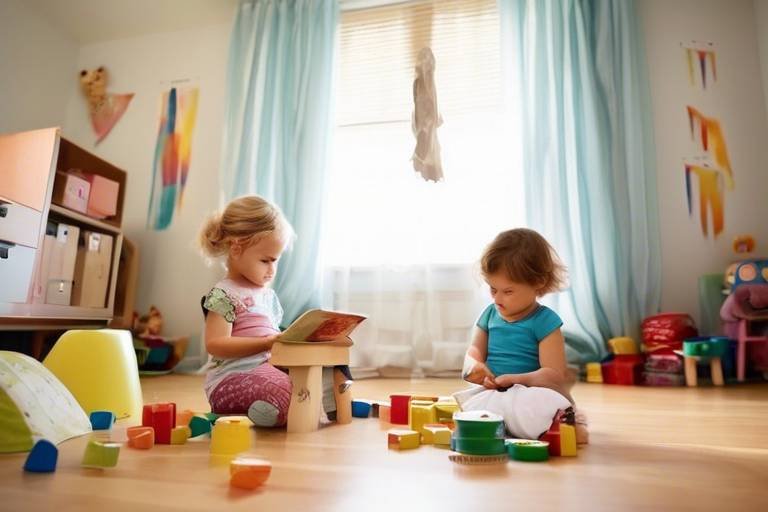Importance of Alone Time in Family Life
In the hustle and bustle of daily life, we often overlook one crucial element that can significantly enhance our family dynamics: alone time. While family togetherness is essential, carving out personal space is equally important for the well-being of each member. Think of it this way: just like a plant needs sunlight and water to grow, individuals need time alone to flourish emotionally and mentally. Alone time allows for personal reflection, rejuvenation, and ultimately contributes to a healthier family atmosphere.
Imagine a family where everyone is constantly together, sharing every moment. While this may seem ideal, it can quickly lead to feelings of suffocation and frustration. Alone time acts as a reset button, enabling family members to recharge and return to their loved ones with renewed energy and appreciation. It’s like taking a deep breath after holding it for too long; the relief is palpable. Understanding the significance of alone time can transform family interactions, leading to more harmonious relationships.
Moreover, alone time isn't just about being physically apart; it's about engaging in activities that promote self-care and personal growth. Whether it’s reading a book, going for a walk, or indulging in a hobby, these moments help individuals reconnect with themselves. Not only does this enhance individual well-being, but it also enriches the family unit as a whole. When each member feels balanced and fulfilled, they bring that positivity back into the family environment.
In this article, we will explore the various dimensions of alone time within family life. From understanding its importance to discussing practical strategies for integrating it into a busy household, we aim to shed light on how alone time can lead to stronger family bonds and healthier relationships. So, let’s dive deeper into the world of personal space and discover how it can transform your family life for the better.
Alone time is essential for personal reflection and self-care. This section delves into what alone time means and why it is particularly important in the context of family life.
Spending time alone can significantly enhance mental health. Here, we discuss how alone time contributes to stress reduction, emotional regulation, and personal growth for each family member.
Alone time fosters creativity by allowing individuals to think freely. This part examines how solitude can lead to innovative ideas and personal projects that benefit the entire family.
Incorporating mindfulness during alone time can improve focus and clarity. This section highlights techniques that families can adopt to enhance their personal time through mindfulness.
Journaling is a powerful tool for self-discovery. Here, we explore how writing can help family members articulate their thoughts and feelings during their alone time.
Alone time can paradoxically strengthen family bonds. This section explains how individual time allows family members to recharge and return to their relationships with renewed energy and appreciation.
Establishing boundaries around alone time is crucial for family members. This part discusses strategies for communicating needs and respecting each other's personal space within the family unit.
A well-structured family schedule can accommodate alone time. This section provides tips on how to integrate personal time into a busy family life effectively.
Teaching children the value of alone time fosters independence. Here, we discuss ways parents can encourage their kids to embrace solitude for their personal development.
Q: Why is alone time important in a family setting?
A: Alone time is crucial as it allows individuals to recharge, reflect, and grow personally, which ultimately enhances family dynamics.
Q: How can I encourage my family to take alone time?
A: Communicate openly about the benefits of alone time and create a family schedule that includes personal time for each member.
Q: What activities are best for alone time?
A: Activities can vary widely but may include reading, journaling, meditating, or pursuing hobbies that bring joy and relaxation.
Q: How can alone time improve family relationships?
A: When family members take time for themselves, they return with renewed energy and appreciation, leading to stronger and healthier relationships.

Understanding Alone Time
This article explores the significance of alone time within family dynamics, emphasizing its benefits for individual well-being, relationship strengthening, and overall family harmony. Understanding this balance is crucial for healthy family interactions.
Alone time is not just about being physically separated from others; it’s a vital aspect of personal reflection and self-care that allows individuals to recharge and reconnect with themselves. In the hustle and bustle of family life, where everyone has their own schedules, responsibilities, and emotional needs, finding time to be alone can feel like a luxury. However, it’s essential to recognize that this time is not merely a break from family duties but a necessary component for maintaining mental and emotional health.
So, what exactly does alone time mean? It can vary from person to person, but generally, it involves engaging in activities that promote self-discovery and relaxation. This could be as simple as taking a walk in the park, indulging in a favorite hobby, or even enjoying a quiet moment with a good book. The key is to create a space where one can think freely without distractions. When family members take the time to be alone, they can reflect on their thoughts and feelings, leading to greater self-awareness and emotional regulation.
Alone time is particularly significant in family life for several reasons:
- Personal Growth: Time spent alone fosters self-exploration, allowing individuals to pursue interests and hobbies that contribute to their identity.
- Stress Relief: Solitude can be a powerful antidote to stress, providing a much-needed break from the demands of family life.
- Improved Relationships: When family members are able to recharge individually, they return to their relationships with renewed energy and appreciation.
Ultimately, alone time serves as a reminder that while family bonds are incredibly important, so is the need for personal space. It’s about finding that sweet spot where individual needs and family dynamics coexist harmoniously. Encouraging each family member to embrace their alone time can lead to a more balanced and fulfilling family life, where everyone feels understood and valued.
Spending time alone can significantly enhance mental health. Here, we discuss how alone time contributes to stress reduction, emotional regulation, and personal growth for each family member.
Alone time fosters creativity by allowing individuals to think freely. This part examines how solitude can lead to innovative ideas and personal projects that benefit the entire family.
Incorporating mindfulness during alone time can improve focus and clarity. This section highlights techniques that families can adopt to enhance their personal time through mindfulness.
Journaling is a powerful tool for self-discovery. Here, we explore how writing can help family members articulate their thoughts and feelings during their alone time.
Alone time can paradoxically strengthen family bonds. This section explains how individual time allows family members to recharge and return to their relationships with renewed energy and appreciation.
Establishing boundaries around alone time is crucial for family members. This part discusses strategies for communicating needs and respecting each other's personal space within the family unit.
A well-structured family schedule can accommodate alone time. This section provides tips on how to integrate personal time into a busy family life effectively.
Teaching children the value of alone time fosters independence. Here, we discuss ways parents can encourage their kids to embrace solitude for their personal development.
Q: How much alone time should each family member have?
A: The amount of alone time needed varies from person to person. It's essential to communicate and understand each other's needs to find a balance that works for everyone.
Q: What are some activities to do during alone time?
A: Activities can range from reading, writing, meditating, or engaging in hobbies. The goal is to do something that brings joy and relaxation.
Q: How can I encourage my children to enjoy alone time?
A: Encourage them to explore their interests independently, provide them with space for their activities, and model the importance of alone time in your own life.

Benefits for Individual Well-Being
Spending time alone can significantly enhance mental health, providing a necessary break from the hustle and bustle of family life. Imagine your mind as a cluttered room; without some time to organize and declutter, it becomes overwhelming. Alone time acts as a broom, sweeping away the chaos and allowing for clarity. When family members carve out moments for themselves, they are not just escaping; they are engaging in a vital process of self-care and reflection.
One of the most profound benefits of alone time is its ability to reduce stress. In today's fast-paced world, stress can feel like a constant companion. However, having the opportunity to step back and breathe can drastically lower anxiety levels. Whether it's reading a book, going for a walk, or simply enjoying a cup of tea in silence, these moments allow individuals to recharge their emotional batteries. Research shows that even short periods of solitude can lead to a significant decrease in cortisol levels, which is often referred to as the "stress hormone." This reduction not only benefits the individual but also contributes to a more harmonious family environment.
Moreover, alone time plays a crucial role in emotional regulation. When family members are constantly interacting, emotions can sometimes run high, leading to misunderstandings or conflicts. By taking time apart, individuals can process their feelings and return with a clearer perspective. This practice encourages better communication and empathy, as each member learns to articulate their needs and emotions more effectively. It’s like tuning an instrument; when each family member is in tune with themselves, the whole family can create beautiful harmony together.
Another significant advantage of alone time is its contribution to personal growth. When individuals have the space to explore their interests and passions, they often discover new aspects of themselves. This can lead to enhanced self-esteem and confidence. For example, someone might take the time to learn a new skill or hobby, which not only enriches their own life but can also inspire and benefit the entire family. Think of it as planting seeds in a garden; as each family member nurtures their own growth, the entire family benefits from the blooming diversity.
Alone time is a fertile ground for creativity. When individuals are free from distractions, their minds can wander and explore new ideas. This solitude allows for innovative thoughts to flourish, leading to personal projects that can engage the whole family. Whether it’s crafting a new recipe, designing a home project, or writing a story, these creative endeavors can bring a fresh spark to family life. It's like giving your brain a blank canvas to paint on, where the possibilities are endless.
Incorporating mindfulness during alone time can further enhance its benefits. Techniques such as meditation, deep breathing, or yoga can improve focus and clarity. These practices encourage individuals to be present in the moment, reducing feelings of overwhelm and enhancing their overall well-being. Families can even explore mindfulness together, creating a shared understanding and appreciation for personal time.
Journaling is another powerful tool for self-discovery during alone time. Writing down thoughts and feelings can help family members articulate what’s on their minds, leading to greater emotional awareness. It’s a way to process the day’s events, celebrate achievements, and even work through challenges. By reflecting on their experiences, individuals can gain insights that contribute to personal growth and healthier family dynamics.
In summary, the benefits of alone time for individual well-being are profound and multifaceted. From stress reduction and emotional regulation to fostering creativity and personal growth, these moments of solitude are essential for maintaining a balanced and healthy family life. By embracing and prioritizing alone time, families can cultivate an environment where each member thrives, ultimately leading to stronger bonds and greater harmony.
- Why is alone time important in family life? Alone time allows individuals to recharge, reflect, and grow, which enhances overall family dynamics.
- How can I encourage my family to embrace alone time? Discuss the importance of personal space and create a family schedule that includes designated alone time for each member.
- What activities can I do during my alone time? You can read, meditate, journal, or engage in hobbies that interest you. The key is to choose activities that help you relax and recharge.

Enhancing Creativity
When we think about creativity, we often envision artists with paintbrushes or writers with their notebooks. However, creativity isn't limited to traditional forms of artistic expression; it permeates every aspect of our lives. Alone time plays a pivotal role in enhancing creativity, allowing individuals the freedom to explore their thoughts without the distractions of daily life. Imagine your mind as a garden; when you give it the space to grow without interference, it can blossom into a vibrant array of ideas and innovations.
Being alone provides a unique opportunity for introspection and brainstorming. In solitude, you can let your thoughts flow freely, unencumbered by the expectations or judgments of others. This is particularly important in family life, where the hustle and bustle can often drown out individual voices. By carving out moments of alone time, family members can engage in activities that stimulate their imagination. Whether it’s doodling in a sketchbook, crafting a story, or simply daydreaming, these solitary moments can lead to breakthroughs that benefit the entire family.
Moreover, alone time fosters a deeper connection with oneself, which is essential for creative expression. When you take the time to understand your feelings, interests, and passions, you can channel that understanding into your creative endeavors. For instance, consider the following activities that can enhance creativity during alone time:
- Brainstorming Sessions: Use a quiet space to jot down any ideas that come to mind, no matter how wild they may seem.
- Mind Mapping: Create visual representations of your thoughts to see connections and explore new paths.
- Exploring New Hobbies: Pick up a new skill or hobby that excites you, like photography or gardening.
Incorporating these activities into your alone time can significantly enhance your creative output. Just as a painter needs a blank canvas, your mind needs the freedom to explore without boundaries. The quiet moments spent alone can lead to a flood of inspiration, sparking ideas that you may not have considered in a more crowded environment.
Furthermore, the act of creating in solitude can also serve as a form of meditation. When you focus on a project or a thought, you enter a state of flow that can be incredibly fulfilling. This flow state not only boosts creativity but also enhances overall well-being, making you feel more accomplished and satisfied with your personal contributions to the family unit.
Ultimately, the time spent alone is not just about being physically apart from others; it’s about nurturing your inner self. By allowing yourself the chance to breathe, think, and create, you return to your family with fresh perspectives and renewed enthusiasm. This, in turn, strengthens family bonds as you share your newfound ideas and projects, enriching your collective experiences.
1. How much alone time should each family member have?
It varies per individual, but generally, aim for at least 30 minutes to an hour of alone time daily. This can be adjusted based on personal needs and family dynamics.
2. What activities are best for enhancing creativity during alone time?
Activities like journaling, painting, or even taking a long walk can enhance creativity. It's all about finding what resonates with you personally.
3. How can I encourage my children to embrace alone time?
Start by modeling alone time yourself. Encourage them to engage in solo activities they enjoy, and explain the benefits of having time to think and create independently.

Mindfulness Practices
In our fast-paced world, it’s all too easy to get swept away in the chaos of daily life, especially within a family setting. That's why during alone time can be a game changer. By incorporating mindfulness, family members can find a sense of calm and clarity, which is essential for personal growth and emotional well-being. But what exactly does mindfulness entail? At its core, mindfulness is about being present in the moment, fully engaging with your thoughts and feelings without judgment. This practice can transform alone time into a powerful tool for self-discovery.
Imagine sitting quietly in a cozy corner, perhaps with a warm cup of tea, and simply observing your thoughts. This practice, known as mindful observation, allows you to step back and watch your thoughts as if they were clouds drifting by. Instead of getting caught up in worries or stressors, you learn to acknowledge them and let them pass. This can be incredibly liberating, especially in a family environment where emotions can run high. By taking the time to practice mindfulness, you’re not only nurturing your own mental health but also setting a positive example for your family.
There are several mindfulness techniques that families can adopt to enhance their personal time:
- Breathing Exercises: Simple breathing techniques can help center your thoughts. Inhale deeply for a count of four, hold for four, and exhale for four. Repeat this cycle to calm your mind.
- Guided Meditations: There are numerous apps and online resources available that offer guided meditations tailored for different needs, whether it's stress relief or enhancing focus.
- Nature Walks: Taking a solitary walk in nature can be a profound way to practice mindfulness. Engage your senses—notice the colors, sounds, and smells around you.
Integrating these mindfulness practices into your alone time can yield remarkable benefits. Not only does it enhance focus and clarity, but it also fosters a deeper understanding of oneself. When family members engage in mindfulness, they return to their relationships with a refreshed perspective, ready to communicate more effectively and empathize with one another. This ripple effect can lead to a more harmonious family dynamic, where everyone feels valued and understood.
In conclusion, mindfulness practices during alone time are not just beneficial; they are essential for nurturing both individual well-being and family relationships. By dedicating time to cultivate mindfulness, each family member can contribute to a more peaceful and loving home environment.
Q: How can I start practicing mindfulness at home?
A: You can start with simple breathing exercises or guided meditations. Set aside a few minutes each day to focus on your breath or listen to a meditation app.
Q: Is mindfulness only for adults?
A: No, mindfulness is beneficial for all ages! Children can practice mindfulness through fun activities like mindful breathing or nature walks.
Q: How can mindfulness improve family relationships?
A: Mindfulness helps individuals manage their emotions better, leading to improved communication and understanding among family members.
Q: How much alone time should each family member get?
A: It varies by individual needs, but aim for at least 15-30 minutes of alone time daily for each family member to recharge.

Journaling and Reflection
Journaling is not just putting pen to paper; it’s a powerful tool for self-discovery and personal growth. In the hustle and bustle of family life, it’s easy to lose sight of our thoughts and feelings. By taking time to journal, family members can articulate their emotions, reflect on their experiences, and gain clarity about their lives. Imagine your mind as a cluttered room; journaling acts like a broom, sweeping away the chaos and allowing you to see things more clearly.
When family members engage in journaling, they create a safe space for their thoughts. This process can be particularly beneficial for children, who may struggle to express their feelings verbally. By encouraging them to write down their thoughts, they can explore their emotions without fear of judgment. This practice not only enhances their emotional intelligence but also strengthens their ability to communicate. Just think about it: when kids learn to articulate their feelings in writing, they are better equipped to share those feelings with their family members later on.
Moreover, journaling can serve as a reflective practice that helps family members understand their individual journeys. For instance, after a challenging day, a parent might write about the stressors they faced and how they managed them. This reflection can lead to insights about coping strategies that might be beneficial for the entire family. It’s like holding up a mirror to one’s life, revealing patterns and behaviors that might otherwise go unnoticed.
Incorporating journaling into your family routine doesn’t have to be complicated. Here are a few simple ideas to get started:
- Create a family journal that everyone contributes to during their alone time.
- Set aside a specific time each week for everyone to write about their experiences.
- Encourage creative expression by allowing family members to draw or doodle in their journals.
As you can see, journaling can be a transformative practice for family members of all ages. It not only promotes self-reflection but also encourages deeper connections within the family. By sharing insights from their journals, family members can foster understanding and empathy, making the family unit stronger and more resilient. So, why not grab a notebook and start this enriching journey of journaling together?
Q: How often should family members journal?
A: There’s no set rule! It can be daily, weekly, or whenever someone feels the need to reflect. The key is consistency and making it a personal practice.
Q: What if someone is unsure about what to write?
A: They can start with prompts such as “What made me smile today?” or “What challenges did I face?” This can help spark ideas and get the writing flowing.
Q: Can journaling really improve family relationships?
A: Absolutely! By articulating thoughts and feelings, family members can communicate better and understand each other on a deeper level, which strengthens relationships.

Strengthening Family Relationships
Alone time might seem counterintuitive when it comes to strengthening family relationships, but it’s like giving each family member a little recharge before diving back into the family dynamic. Just imagine a phone that’s constantly being used without ever being charged; it won’t take long before it dies. Similarly, when family members don’t take time for themselves, they can become irritable and emotionally drained, leading to tension and misunderstandings. By allowing each person their own space, they can reflect, relax, and return to the family unit with a fresh perspective and renewed appreciation for one another.
When individuals have the opportunity to engage in their own interests or simply enjoy some quiet time, they often find themselves reflecting on what they value about their family. This reflection can lead to a deeper understanding of each other’s quirks, strengths, and weaknesses. For instance, after spending time alone, a parent might realize how much they appreciate their child's creativity, or a sibling might come to understand the pressures their brother feels in school. This newfound appreciation can foster a more supportive atmosphere when they come together again.
Moreover, alone time gives family members the chance to process their emotions independently. It's normal for conflicts to arise in any family, but having space to think things through can help individuals approach these situations with clarity and calmness. When tensions are high, it’s often better to step back and take a breather rather than engage in heated arguments. By doing so, family members can return to discussions with a level head, ready to communicate effectively and resolve issues.
In addition, alone time can serve as a reminder of the importance of personal interests and hobbies. When family members pursue their passions independently, they bring back stories, experiences, and even new skills to share with the family. This sharing can enrich family conversations and activities, making the time spent together more enjoyable and engaging. It’s like adding new colors to a painting; each person contributes their unique hue, creating a vibrant family portrait.
Ultimately, the magic lies in balance. While family bonding is essential, it’s equally important to recognize that each member needs their own time to grow individually. By embracing alone time, families can cultivate a deeper connection, understanding, and appreciation for one another, leading to a more harmonious home environment. So, the next time you feel the need for a little solitude, remember: it’s not just good for you; it’s good for the family, too!
- Why is alone time important for families? Alone time allows each family member to recharge, reflect, and grow individually, which ultimately strengthens family bonds.
- How can I encourage my children to take alone time? Teach them the value of solitude by modeling it yourself and providing them with a space where they can engage in activities they love.
- What are some activities families can do together after taking alone time? Families can share stories, play games, or engage in creative projects that incorporate the interests developed during their alone time.
- How do I balance alone time with family time? Create a family schedule that includes designated alone time for each member, ensuring everyone has the opportunity to recharge.

Setting Boundaries
Setting boundaries around alone time is a vital component in maintaining a harmonious family environment. Just like a garden needs space for each plant to thrive, family members require their own personal space to grow and flourish. It's essential to recognize that while family time is important, so is the time spent alone. This balance can lead to a more fulfilling family life where everyone feels valued and understood.
To effectively establish these boundaries, open communication is key. Families should engage in honest discussions about their individual needs for alone time. This can be as simple as asking, "Hey, do you need some time to yourself today?" or "What do you think about setting aside an hour each evening for personal reflection?" Such conversations can help create an atmosphere of respect and understanding, allowing each member to express their needs without fear of judgment.
Additionally, it’s crucial to respect each other's personal space. Just as we wouldn't walk into a friend's home uninvited, we should honor the privacy of our family members. This means knocking before entering a room, not interrupting during their alone time, and acknowledging that everyone has the right to their own space. By doing this, family members can feel secure in their need for solitude, knowing that their boundaries are respected.
To help facilitate this understanding, families might consider creating a simple visual aid, like a family schedule, that outlines designated alone time for each member. This can be a fun project where everyone contributes their preferred times for solitude. Here’s a basic example of what that might look like:
| Family Member | Preferred Alone Time |
|---|---|
| Mom | 7:00 PM - 8:00 PM |
| Dad | 8:00 PM - 9:00 PM |
| Child 1 | 5:00 PM - 6:00 PM |
| Child 2 | 6:00 PM - 7:00 PM |
By having a visual representation of each person's alone time, families can better understand and respect each other's needs. This not only fosters an environment of cooperation but also encourages everyone to take their personal time seriously. Remember, setting boundaries is not about creating distance; instead, it's about cultivating a nurturing space where each family member can recharge and return to the family unit with renewed energy and a positive outlook.
In conclusion, establishing boundaries around alone time is essential for individual well-being and overall family harmony. When family members communicate their needs effectively and respect each other's space, it leads to a healthier, more supportive family dynamic. So, why not sit down together and start discussing how to make alone time a priority in your home? You might be surprised at how much stronger your family bonds become as a result!
- Why is alone time important in family life?
Alone time allows individuals to recharge, reflect, and grow, which ultimately strengthens family relationships. - How can I communicate my need for alone time to my family?
Be open and honest about your needs. Use simple language and encourage a two-way conversation. - What if my family struggles to respect my alone time?
Consider creating a family schedule that outlines everyone’s alone time, reinforcing the importance of personal space. - Can alone time help with stress management?
Absolutely! Alone time can provide a much-needed break from daily stresses, allowing for emotional regulation and personal growth.

Creating a Family Schedule
When it comes to family life, finding the right balance between togetherness and alone time can feel like walking a tightrope. However, creating a well-structured family schedule can be a game-changer, allowing everyone to enjoy their personal space while still cherishing family interactions. Imagine a world where everyone knows when they can retreat into their own bubble of creativity or relaxation, while also looking forward to shared family moments. Sounds perfect, right?
To kick things off, it’s essential to sit down as a family and discuss everyone’s needs and preferences. This open dialogue not only helps in understanding each other better but also promotes a sense of ownership in the scheduling process. Each family member should feel heard and valued, which can significantly enhance the overall family dynamic. Consider establishing a weekly family meeting where everyone can voice their thoughts about their schedules, including when they would prefer some alone time.
Once you’ve gathered everyone’s input, you can start mapping out a schedule that accommodates both family activities and personal time. Here’s a simple framework to consider:
| Day | Family Activity | Personal Time |
|---|---|---|
| Monday | Family Game Night | 1 hour of reading |
| Tuesday | Movie Night | 30 minutes of journaling |
| Wednesday | Cooking Together | 1 hour of outdoor play |
| Thursday | Family Walk | 1 hour of art or craft |
| Friday | Family Dinner Out | Personal time to unwind |
| Saturday | Adventure Day | Free time for hobbies |
| Sunday | Planning for the Week | Self-care time |
This sample schedule is just a starting point. Feel free to adjust it based on what works best for your family. The key is to ensure that everyone has dedicated time for themselves, while also enjoying those precious moments together. Think of it as a dance; sometimes you lead, and other times you follow, but the rhythm keeps everyone in sync.
Moreover, be flexible! Life can throw curveballs, and it’s okay to adapt the schedule as needed. Encourage each family member to communicate any changes they may need in their personal time and family activities. This not only helps in maintaining harmony but also teaches everyone the importance of compromise and understanding.
In conclusion, creating a family schedule that balances togetherness and alone time is vital for nurturing healthy relationships and personal well-being. By taking the time to plan, communicate, and adjust, your family can thrive in both individual pursuits and shared experiences.

Encouraging Independence in Children
Encouraging independence in children is not just about letting them play alone; it's about fostering a sense of self-reliance that will serve them throughout their lives. Imagine your child as a little bird learning to fly. At first, they may wobble and struggle, but with your support, they’ll eventually soar. Giving children the opportunity to spend time alone allows them to discover their interests, develop problem-solving skills, and build confidence. It’s essential to create an environment where they feel safe to explore their own thoughts and ideas without constant supervision.
One effective way to encourage this independence is by setting aside specific times for children to engage in solo activities. This could be as simple as designating a quiet hour each day where they can read, draw, or play with toys on their own. During this time, parents can model the value of alone time by engaging in their own activities. This not only shows children that alone time is important but also normalizes the practice within the family dynamic.
Additionally, it’s crucial to communicate openly with children about the benefits of alone time. You can explain that just like adults need time to recharge after a long day, they too can benefit from stepping back and enjoying their own company. Encourage them to express how they feel during these moments. Perhaps they’ll find that they can think more clearly or come up with creative ideas when they’re not distracted by others. This dialogue can deepen their understanding and appreciation for solitude.
Moreover, parents should celebrate their child's achievements during these independent moments. Whether they finish a puzzle, create a masterpiece, or simply enjoy a book, acknowledging their efforts reinforces their ability to thrive on their own. You might even consider keeping a "success journal" where children can write or draw about what they accomplished during their alone time. This not only boosts their self-esteem but also helps them reflect on their personal growth.
In the long run, these practices will help children develop a healthy relationship with solitude. They will learn that being alone doesn’t mean being lonely. Instead, it’s an opportunity for self-discovery and creativity. By encouraging independence, you are equipping your children with the tools they need to navigate life’s challenges with confidence and resilience.
- Why is alone time important for children? Alone time helps children develop self-reliance, creativity, and emotional regulation. It allows them to explore their interests and recharge their minds.
- How can I encourage my child to enjoy alone time? Set specific times for solo activities, communicate the benefits of solitude, and celebrate their achievements during these moments.
- What activities are suitable for children during alone time? Activities like reading, drawing, playing with toys, or even engaging in mindfulness exercises are great for fostering independence.
- At what age should I start encouraging my child to spend time alone? You can start encouraging alone time as early as preschool age, gradually increasing the duration as they grow older and more comfortable with solitude.
Frequently Asked Questions
- What is alone time and why is it important in family life?
Alone time refers to moments spent by oneself, away from family interactions. It's crucial in family life because it allows individuals to recharge, reflect, and focus on personal growth. Just like a phone needs to be charged to function properly, family members need their alone time to maintain their emotional and mental well-being.
- How does alone time benefit individual well-being?
Spending time alone significantly enhances mental health. It helps reduce stress, improves emotional regulation, and fosters personal growth. Think of it as a mini-vacation for the mind, where you can escape the noise and chaos, leading to a clearer perspective and better mood.
- Can alone time actually strengthen family relationships?
Absolutely! Paradoxically, taking time for oneself can enhance family bonds. When family members take a break to recharge, they return with renewed energy and appreciation for each other, making interactions more meaningful and enjoyable.
- How can families set boundaries around alone time?
Establishing boundaries is essential for respecting each other's need for personal space. Families can communicate openly about their alone time needs and agree on designated quiet times. This makes sure everyone understands the importance of this personal space, just like respecting a "do not disturb" sign.
- What are some effective ways to create a family schedule that includes alone time?
Creating a family schedule that accommodates alone time involves planning ahead. Families can use calendars to block out specific times for personal activities, ensuring that everyone has their space. It's like weaving a tapestry; each thread represents an individual's time, creating a beautiful, balanced family life.
- How can parents encourage their children to value alone time?
Parents can teach children the importance of alone time by modeling it themselves. Encourage kids to engage in solo activities like reading, drawing, or simply enjoying nature. This not only fosters independence but also helps them understand the benefits of solitude, much like planting seeds for future growth.


















